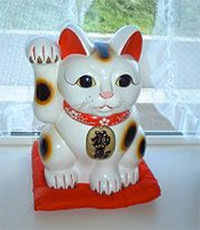

- White: Inviting good luck
- Black: Avoiding sickness
- Gold: Inviting Money
- Raising Left Hand: Inviting visitors
- Raising Right Hand: Inviting Money
- Pink: Love
- Blue: Traffic safety
- Yellow: Feng shui good luck



Don’t hesitate to contact us. We are an expert team and we are happy to talk to you.
1.866.316.7268

Thanks Mike. Great blog. Now I know that my Maneki-neko, which I bought on our spring 2006 Samurai Tours trip, is inviting good luck and money!